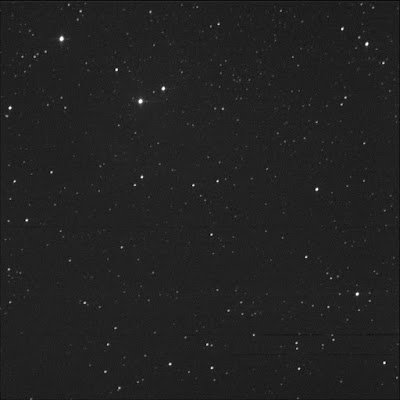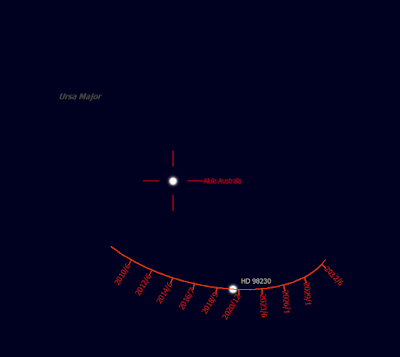Clear! Yeh! Set up in the back yard. Chris said he was going for the Moon and my double stars. I wanted to knock down a few more doubles...
Startled a bunny as I transferred things to my workspace...
Instrument: Meade ETX-90 Maksutov
Mount: fork mount with tracking motor, tripod
Method: star hopping, with angle finder
For the first time, I tried the light shield. It did not take a lot of time to set up, happily. The old black fabric material from "the Overlook" porch perch from Colbeck. Hung from the same poles which were attached to my folding wagon. I positioned the mobile blind south of my seat so to block the stupid street light from Frederick. It looked like it would work well. Maybe moot given all the moonlight... But it was in part an experiment.
I was warm after all the moving around. I had many layers on including long underwears and the winter coat. And my winter boots.
9:12 PM, Friday 1 May 2020. Fired up the Sony recorder. Battery level at half; 10 hours of space.
Mounted the ETX to the Mamiya tripod via the hex plate.
9:16 PM. Unscrewed the cover from the optical tube assembly.
Noted the Moon surrounded by stars. Just past first quarter. Ah, Leo. Regulus below, Denebola to the left. The Moon was in the handle of the Sickle.
Spotted Arcturus to the east. Ew. The seeing was bad.
Started preparing SkyTools.
9:21. Initiated the polar drift alignment routine in SkyTools. Quickly loaded up the Celestron Micro Guide. ST3P directed me to a star in Sextans, at the intersection of the meridian and the celestial equator. Faint star. I didn't feel like making a long star hop to the exact suggestion so I chose something in that area. Got confused at one point, turning the wrong way in azimuth. "Turn the forks east!" OK.
9:44. Switched from east/west to up/down. ST3P sent me to the east part of the celestial equator.
9:49. Slight drift but I was happy. Didn't want to fiddle with the Manfrotto head. Removed the reticule ocular.
OK. Ready to begin the evening campaign! Applied filters in SkyTools. Considered HD 63241, a "neglected" double I had already tried to check, already imaged with the BGO. But too low, unfortunately, in the trees.
Headed to HD 73668 in Hydra. Seemed familiar...
10:02. Right! Already logged Struve 1255. OK, whatever. Yellow and orange. Very faint. Barely detectable (with the moon glow) in the finder. But a pretty easy target overall, in the head of the sea monster.
Next?
Adjusted the star settings in the software, trying to improve the Visual Sky Simulation telescope 3-way view. It's a catch-22. To be able to see the stars in the finder, they need to be a certain size; but that affects the eyepiece view where tight double bloat and merge together.
10:08. Confirmed I was at HR 3963 aka Burnham 1072. I had found this target on the Astronomical League's double star binocular list.
Dropped the star brightness a bit.
Wide pair at 48 power. Blue or blue-white and orange. Nice double but faint. I star hopped from Alphard so not too difficult. Oriented 10 o'clock to 4 o'clock. An east-west angle according to the computer. About 1 magnitude different I guessed. [ed: I was seeing the A and C stars at magnitudes 6.3 and 7.2 with a 20.9 arc-second separation. The B star will need more aperture.]
Noted another pair, to the north-east, almost aiming toward HR. Two in the view. This duo with HD 87425 was not shown as an official double in the planning software.
[ed: Checked the WDS. No entry for this.]
Seeing went away... Got really bad. Hard to focus, even with the new clothespin arm.
Bored drivers ripped around town. Neighbours hacked on their doobies.
Star hopped from Regulus bound for my next quarry.
10:24. Landed at 18 and 19 Leonis. Variable star R was part of the little triangle.
18 was at the 11 o'clock position, for me (north-west). Brighter than 19. A little east of 18 was SAO 98762. Stood up to direct vision at magnitude 9.1. Saw a far away star inline with 18 and SAO: Tycho 831-203-1 at magnitude 9.8. Nothing notable near 19. R Leonis was in a curve of stars with 18 and 19. It was the eastern point of the small triangle. Slightly brighter... all pretty close, those 3 stars. Centred on it.
10:27. Southern star: TYC 00831-1223 1, magnitude 9.9, direct vision. The north star was the second brightest. The north star: PPM 126787, 9.2.
Spotted a star south-east of the triangle. PPM 126807, 10.0.
[ed: Looks like I have visited R Leo during it's minimum. A year from now, it will be near its max... Made a calendar entry. Some info is available at the AAVSO
page.]
Some bigoted dudes had a little party in the driveway. OK. Hoped they wouldn't stumble across me.
Hoped the crazy neighbour wasn't gonna let his crazy mutt out unleashed.
Wanted to go for VZ Cancri... Really wanted to get it. But the longer it took for me to navigate to it, the deeper it fell into the western trees. Gave up.
Considered some of the next targets as suggested in the ordered list. Talitha in Ursa Major, stars in the Giraffe. They were setting, getting blocked by the roof of the house. Re-evaluated. Oh. How about the back feet of the Great Bear? Cool, wasn't expecting to get these.
Arrived Alula Borealis (ν or nu) and Australis.
10:51. Viewed ξ (xi) Ursae Majoris. Very equal, in brightness and colour. 11 o'clock, 5. Fainter one to the south. I could easily see the split in the 20mm Pentax (around 60 power). Wanted to go to higher power.
I thought the view in the software wasn't right... No, it was pretty close.
10:55. Checked the Oregon Scientific portable weather station. Relative humidity was 49%, air temperature 6.9°C, pressure steady, clouds showing, i.e. cloudy conditions in 24 hours.
Verified the B star was to the south. The faint dipper shape was to my left, WWWS. Sheesh, very close to each other...
Loaded up the Tele Vue Nagler 9mm. Wow.
10:58. Looked great at 139 power. Equal round airy discs. Seeing was good. Very interesting diffraction rings, nearly symmetrical. B was on the first diffraction circle. Same colour. Wow.
This meant the B companion was east-east-south, nearly so south-east.
What?! 2.2 seconds of arc?! Fire trucking wild.
Great to see that.
Headed to Borealis. Nothing obvious.
Went back down to the 20mm for Borealis. aka Σ1524.
Wondered about making these eyepieces parfocal...
Saw the star far to the west, HD 98216.
The software made it seem that it was doable. 10.1 mag. 7.1" away. That it showed it! But I couldn't see it. Must have been buried in the glare (mag 3.5) of the A star.
Then back to the 9mm. Couldn't see anything. Three or four diffraction rings... Gah!
Break time. Went inside for a bottle of water.
11:15. Back. Water. And some jelly beans!
Next target was in Leo.
Swapped oculars again.
Swapped oculars again.
Nope. Nothing in the 9 or 20.
11:29. I could not see the partner in 81 Leo. Dim, to be sure. Mag 10.8. Darn.
Noticed more wispy cloud bands.
Moving on. Corvus? The bottom half, with beta, was in the trees.
Oh. Spotted a note about a naked eye pair in Corvus. Walked west a bit to get into the notch. Nothing obvious... I could see δ (delta) at the top-left, γ (gamma) top-right, β (beta) bottom-left, ε (epsilon) bottom-right no problem.
It's curious how dim α (alpha) is in this constellation.
Cheated. Scanned around on the computer screen. SkyTools showed it near the bottom of the big diamond asterism. ζ (zeta) is roughly between β and ε.
Rhonda, yawning, ventured outside. "Hark." She noted it was very clear. Indeed.
Offered a view of the Moon. Loaded the Celestron 26mm. While I aimed, she fetched a coat. I tried to use my bad eye...
Reminded rho of my super-duper expensive sophisticated focuser system. "Oh, cool. Wow. I love the Moon."
I grabbed the Rod Ends binoviewer and the 20mm XW eyepieces. Wasn't sure it would work but the angle was perfect. Again, challenging being at the end of the primary mirror movement. A great view. Filled the field.
Hint of yellowing in the dual viewer. A bit dimmer, which was not a bad thing.
Rhonda thought if the blind was white I could show outdoor movies. Hmmm...
It looked really nice. Gave her the helm. Encouraged her to push in with the eyepieces. Showed her how to change the interocular distance. Settle in.
She asked if we could see the Sea of Tranquillity. I said I didn't know. [ed: It was right there! With the Apollo 11 landing site near the bottom edge!]
I pointed out the crater near the centre, along the terminator. Perfectly round. Text book. [ed: Copernicus.]
The curved mountain range [ed: Mons Huygens] was the crater wall around the old massive hit. [ed: Mare Imbrium.]
I could see lava flows, ridges. [ed: In Mare Nubium.]
Rays through large northern mare. [ed: Mare Serenitatis.]
Super bright white crater in the east.
Rays from the small crater in the south. [ed: Tycho.]
Some of the medium-size craters in the south looked incredibly deep. Big hits... [ed: Including Longomontanus.]
Rhonda asked about my photos. Oh. I decided not to do that given the moonlight. I want some long exposures with bobbing red trails from my work area and the star traces rising up out of the hedge...
Pointed on the interesting crater near the south [ed: Clavius] with a bunch of little craters, boom, boom, boom, in the middle. [ed: Rutherford, Clavius D, Clavius C, Clavius N, and Clavius J.] And a "late one" on the rim wall. [ed: Porter.]
She noted there was no wind. I said I had been worried that my mobile blind cart might topple over in a strong breeze. "It's like a sail." Indeed. I could collect some jugs and fill them with water as needed.
Three similar, equally distant, small craters near the centre of the lit region. [ed: Pickering, Hipparchus G, and Hip C.]
The seeing went bad.
Choppers! "Incoming."
More clouds. Oh, quite a lot. I asked the time. Rhonda said it was around midnight. Really, wow. OK. So then those clouds were on schedule...
Switched to super-high power for the Moon. Showed rho how to pan with the declination knob. She enjoyed exploring. She noted the presentation; I reminded her this 'scope flipped the view, laterally, like a mirror.
She asked what the average size or diameter of the craters was. I guess 100 km. Then I tried to remember the size of the Algonquin crater... 50?
We talked a big about the history of our satellite.
Hawkeye spotted stars near the Moon.
She noted the bright yellow star in the east. I gave some hints. Arcturus.
I started pre-packing. Rhonda heard the little animals moving in the hedge. No skunks. One bird peeping.
Headed to easy double star ν (nu) Draconis. "Dracula?" asked Rhonda. Well, the Dragon, yes. She thought them equal. "The Dragon's Eye." Looked nice in the little 'scope. [ed: aka Kuma.]
Clouds had pushed off to the south. If to the north, they could be mistaken for aurora.
I wanted to know if Hawkeye could see ζ Corvi with just eyeballs but my green laser pointer would not start up properly... Man!
I had HR 4691 on my list but then on checking the Object Information box in SkyTools learned that it was crazy difficult, a very tight pair, way below my life limit for splits. Part of the zeta group. It must be that HR 4691 A is considered the naked eye partner to zeta proper (mag 5 stars).
Last one, with Corvus was in the notch. Moved the blind a bit. Aimed for Algorab. A challenge. Rhonda was up for it. "Oh yeah, really faint." I pointed out the flying V shape. She had trouble with the field. And then John Repeat Dance shutdown—battery done! OK. That's was probably a sign...
Rhonda helped me take down and stow the blind and lug gear to the loading dock...
Checked the humidity: 54%. Did I see around 5½°?
Knocked a picture frame to the floor as I moved things inside. Rhonda worried; no, not a telescope smashing!
1:03 AM, Saturday 2 May 2020. Inside. Grabbed the computer to charge it up.
Time for a night cap, a snoot of whiskey, to wind down.
§
So, a good evening, overall.
Polar alignment was really good. No appreciable movement at low and medium power magnification. So I think I'm good with the overall drift process. And certainly using SkyTools makes it easy.
Did not do quite as much as I wanted in terms of double star sightings but was really happy tagging Alula Australis!
The portable light shield was great!
A regret: I forgot to look for Rupes Recta aka The Railroad!
Need to check the GLP again...
Didn't get anywhere near ETX mag limit of 11.6. But then, the Moon...
§
Moon image from NASA
Scientific Visualisation Studio.

















